Artículo
Are all patches worth exploring? Foraging desert birds do not rely on environmental indicators of seed abundance at small scales
Fecha de publicación:
06/2019
Editorial:
BioMed Central
Revista:
BMC Ecology
ISSN:
1472-6785
Idioma:
Inglés
Tipo de recurso:
Artículo publicado
Clasificación temática:
Resumen
Background: Consumers should show strong spatial preferences when foraging in environments where food availability is highly heterogeneous and predictable. Postdispersal granivores face this scenario in most arid areas, where soil seed bank abundance and composition associates persistently with vegetation structure at small scales (decimetres to metres). Those environmental features should be exploited as useful pre-harvest information, at least to avoid patches predicted to be poor. However, we did not find the expected spatial association in the algarrobal of the central Monte desert by observing foraging seed-eating birds, a field technique influenced by how much they exploit visited patches. In this work we tested if the first stage of foraging by granivorous birds (patch visit, encounter or exploration) is positively associated with environmental indicators of patch quality by recording the removal of single seeds from 300 scattered experimental devices during seasonal trials. Spatial selectivity was analysed by comparing the structural characteristics of used vs. available microhabitats, and evaluated against bottom-up and top-down hypotheses based on our previous knowledge on local seed bank abundance, composition and dynamics. Their foraging activity was also explored for spatial autocorrelation and environmental correlates at bigger scales.
Results: Postdispersal granivorous birds were less selective in their use of foraging space than expected if microhabitat appearance were providing them relevant information to guide their search for profitable foraging patches. No microhabitat type, as defined by their vegetation structure and soil cover, remained safe from bird exploration. Analyses at bigger temporal and spatial scales proved more important to describe heterogeneity in seed removal.
Conclusions: Closeness to tall trees, probably related to bird territoriality and reproduction or to their perception of predation risk, seemed to determine a first level of habitat selection, constraining explorable space. Then, microhabitat openness (rather than seed abundance) exerted some positive influence on which patches were more frequently visited among those accessible. Selective patterns by birds at small scales were closer to our predictions of a top-down spatial effect, with seed consumption creating or strengthening (and not responding to) the spatial pattern and dynamics of the seed bank.
Archivos asociados
Licencia
Identificadores
Colecciones
Articulos(CIEMEP)
Articulos de CENTRO DE INVESTIGACION ESQUEL DE MONTAÑA Y ESTEPA PATAGONICA
Articulos de CENTRO DE INVESTIGACION ESQUEL DE MONTAÑA Y ESTEPA PATAGONICA
Articulos(IEGEBA)
Articulos de INSTITUTO DE ECOLOGIA, GENETICA Y EVOLUCION DE BS. AS
Articulos de INSTITUTO DE ECOLOGIA, GENETICA Y EVOLUCION DE BS. AS
Articulos(INIBIOMA)
Articulos de INST. DE INVEST.EN BIODIVERSIDAD Y MEDIOAMBIENTE
Articulos de INST. DE INVEST.EN BIODIVERSIDAD Y MEDIOAMBIENTE
Citación
Milesi, Fernando Adrian; Lopez de Casenave, Javier Nestor; Cueto, Víctor; Are all patches worth exploring? Foraging desert birds do not rely on environmental indicators of seed abundance at small scales; BioMed Central; BMC Ecology; 19; 1; 6-2019; 1-17
Compartir
Altmétricas




